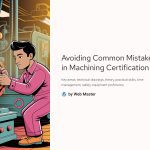 With the rising demand for skilled technicians in the era of smart manufacturing, the Machining Certification has become one of the most valuable technical licenses. From CNC operators to precision toolmakers, this certification opens doors to high-demand industries like semiconductors, automotive, and aerospace. However, many candidates struggle due to the test’s highly practical and detail-oriented nature. This guide reveals expert-level strategies to not just pass but excel in your machining exam preparation—designed for faster learning, stronger retention, and higher scores.
With the rising demand for skilled technicians in the era of smart manufacturing, the Machining Certification has become one of the most valuable technical licenses. From CNC operators to precision toolmakers, this certification opens doors to high-demand industries like semiconductors, automotive, and aerospace. However, many candidates struggle due to the test’s highly practical and detail-oriented nature. This guide reveals expert-level strategies to not just pass but excel in your machining exam preparation—designed for faster learning, stronger retention, and higher scores.

Understand the Exam Structure Before You Start
Before diving into textbooks or YouTube tutorials, start by fully understanding the structure and scope of the machining certification. The test typically consists of a written theory exam and a practical hands-on test, each requiring different types of preparation.
The theory test often covers subjects like mechanical drawing interpretation, materials science, metrology, and CNC basics. In contrast, the practical test focuses on tool handling, setup, and precise machining operations using equipment such as lathes and milling machines.
Knowing what to expect allows you to allocate time and focus appropriately. Don’t just study randomly—structure your efforts based on what’s weighted more heavily in the test and what your weak points are. This simple mindset shift can cut study time in half and double your efficiency.

Build a Custom Study Schedule and Stick to It
Creating a structured study timetable tailored to your learning style is one of the most effective ways to ensure consistent progress. Divide your time between theory and practical training, allocating more hours to weaker subjects.
Set weekly goals: For instance, Week 1 might focus on blueprint reading, while Week 2 focuses on tolerancing and GD&T. Don’t forget to include buffer days for review and mock testing. Visual learners should also consider adding infographics and 3D modeling videos to reinforce concepts.
Digital tools like Google Calendar, Notion, or Trello can help you track your goals. Keeping a record of what you’ve learned not only motivates but also lets you spot areas that need more review.

Practice with Real Tools: Simulate the Exam Environment
Machining is a hands-on skill. Reading books alone won’t make you proficient. Make sure to get actual shop time on the machines you’ll be tested on—manual lathes, CNC mills, or even simulators.
Recreate exam scenarios. For example, time yourself while machining a workpiece within specific tolerances. This will help reduce anxiety during the real test and make you more confident in operating under pressure.
Also, ensure you know safety protocols by heart. Examiners often deduct points for even minor safety oversights, such as incorrect PPE usage or not checking spindle speeds.

Use Smart Memorization Techniques for Theory
Theory sections can feel overwhelming due to the technical jargon and formulae. Instead of rote memorization, apply active recall techniques and spaced repetition to lock in complex concepts.
Tools like Anki flashcards, Quizlet decks, or handwritten summaries help break down dense material into manageable chunks. Make mind maps for chapters such as “Cutting Speeds & Feeds” or “Tool Geometry” to visualize connections.
Teaching what you’ve learned to others, even if just in a mirror or study group, dramatically enhances retention. If you can explain the concept, you’ve mastered it.

Analyze Past Exam Papers and Solve Mock Tests
Old exam papers are gold. Not only do they show you the most frequently asked questions, but they also help you understand the pattern, language, and difficulty level of actual questions.
Dedicate time to solving past 3 years’ papers under timed conditions. After finishing, thoroughly review your mistakes. Was it a concept issue or a misreading of the question? This post-analysis is where real growth happens.
Use mock tests as benchmarks to track your progress. Don’t aim for perfection on your first try—use them to refine your strategy and adjust your study plan accordingly.

Stay Updated with Latest Technology and Standards
Machining is a rapidly evolving field, with advancements in tooling materials, automation, and programming happening constantly. Staying current not only helps in theory but can give you a competitive edge during interviews or practical evaluations.
Subscribe to industry blogs, follow influencers in precision machining on LinkedIn, and join forums like Practical Machinist or CNCzone. Even a few minutes daily can keep you informed about new standards or exam changes.
Many certification boards update their guidelines yearly. Make sure your study material isn’t outdated by cross-checking with the official board or trusted institutions.
Check Updated Certification Guides
*Capturing unauthorized images is prohibited*




